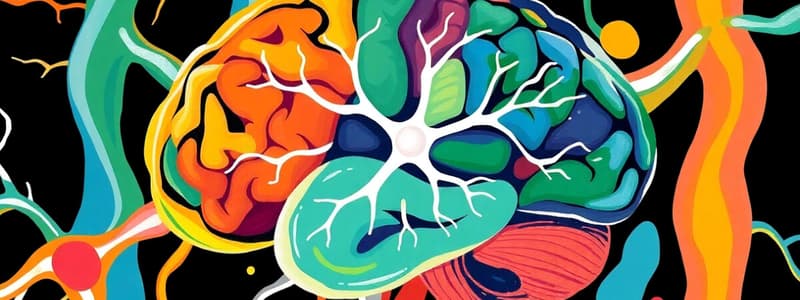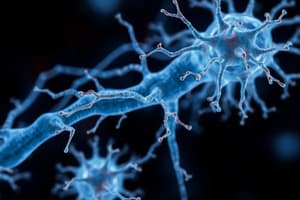Podcast
Questions and Answers
Which nervous system controls the voluntary movement of skeletal muscles?
Which nervous system controls the voluntary movement of skeletal muscles?
- Sympathetic Nervous System
- Parasympathetic Nervous System
- Autonomic Nervous System
- Somatic Nervous System (correct)
The autonomic nervous system is responsible for regulating activities like breathing and digestion.
The autonomic nervous system is responsible for regulating activities like breathing and digestion.
True (A)
What are the two main subdivisions of the autonomic nervous system?
What are the two main subdivisions of the autonomic nervous system?
Sympathetic and parasympathetic
The ______ nervous system prepares the body for "fight or flight" responses.
The ______ nervous system prepares the body for "fight or flight" responses.
Match the following functions with the appropriate nervous system subdivision:
Match the following functions with the appropriate nervous system subdivision:
What are the two major divisions of the nervous system?
What are the two major divisions of the nervous system?
The cauda equina is a bundle of nerves that carries information to and from the pelvic organs and lower limbs.
The cauda equina is a bundle of nerves that carries information to and from the pelvic organs and lower limbs.
What is the fluid that surrounds and protects the brain and spinal cord?
What is the fluid that surrounds and protects the brain and spinal cord?
The ______ is a bundle of nerves that connects the brain to all other parts of the body.
The ______ is a bundle of nerves that connects the brain to all other parts of the body.
Match the following divisions of the nervous system with their corresponding functions:
Match the following divisions of the nervous system with their corresponding functions:
Which of the following is NOT a function of the central nervous system (CNS)?
Which of the following is NOT a function of the central nervous system (CNS)?
What are neurotransmitters?
What are neurotransmitters?
The somatic nervous system regulates involuntary actions such as breathing and heartbeat.
The somatic nervous system regulates involuntary actions such as breathing and heartbeat.
Flashcards
Nervous System
Nervous System
Controls and coordinates functions throughout the body and responses to environment changes.
Neurons
Neurons
Cells that transmit electrical signals in the nervous system.
Neurotransmitters
Neurotransmitters
Substances released by neurons to signal other cells (e.g., muscles, glands).
Central Nervous System (CNS)
Central Nervous System (CNS)
Signup and view all the flashcards
Peripheral Nervous System (PNS)
Peripheral Nervous System (PNS)
Signup and view all the flashcards
Somatic Nervous System
Somatic Nervous System
Signup and view all the flashcards
Autonomic Nervous System
Autonomic Nervous System
Signup and view all the flashcards
Cerebrospinal Fluid (CSF)
Cerebrospinal Fluid (CSF)
Signup and view all the flashcards
Sympathetic Nervous System
Sympathetic Nervous System
Signup and view all the flashcards
Parasympathetic Nervous System
Parasympathetic Nervous System
Signup and view all the flashcards
Fight or Flight Response
Fight or Flight Response
Signup and view all the flashcards
Study Notes
Nervous System Overview
- The nervous system controls and coordinates bodily functions, directing responses to environmental changes.
- Information is transmitted via electrical signals carried by neurons.
- Neurons release neurotransmitters, triggering responses like muscle contractions and hormonal releases.
- The nervous system comprises the brain, spinal cord, and peripheral nerves.
Brain Structure and Protection
- The brain sits atop the body, protected by the skull.
- The brain is encased in protective cerebrospinal fluid (CSF) and meninges.
- CSF and meninges act as a cushion, protecting the brain and spinal cord.
Spinal Cord Structure and Function
- The spinal cord is a nerve bundle connecting the brain to body parts.
- It relays information between the brain and body.
- Spinal nerves, part of the peripheral nervous system, connect to the spinal cord, transmitting signals.
- At the spinal cord’s end, nerves form the cauda equina, resembling a horse’s tail; conveying information to and from pelvic organs and lower limbs.
Divisions of the Nervous System
- Central Nervous System (CNS): Composed of the brain and spinal cord, relays messages, processes, and analyzes information.
- Peripheral Nervous System (PNS): Comprises all other nerves, receives environmental inputs, relays commands from the CNS to the body.
Peripheral Nervous System (PNS) Subdivisions
- Sensory Division: Transmits signals from sense organs to the CNS.
- Motor Division: Transmits signals from the CNS to muscles or glands, further divided into:
- Somatic Nervous System: Controls voluntary skeletal muscle movements.
- Autonomic Nervous System: Regulates involuntary actions, like heart rate and digestion. Divided into:
- Sympathetic Nervous System: Increases bodily activities like heart rate, breathing and sweating, primes "fight or flight" response (e.g., constricting blood vessels, widening bronchial tubes.)
- Parasympathetic Nervous System: Slows bodily activities, stimulates digestion, urination, salivation, and lowers heart rate and respiration (generally opposite effects to the sympathetic system).
Studying That Suits You
Use AI to generate personalized quizzes and flashcards to suit your learning preferences.




